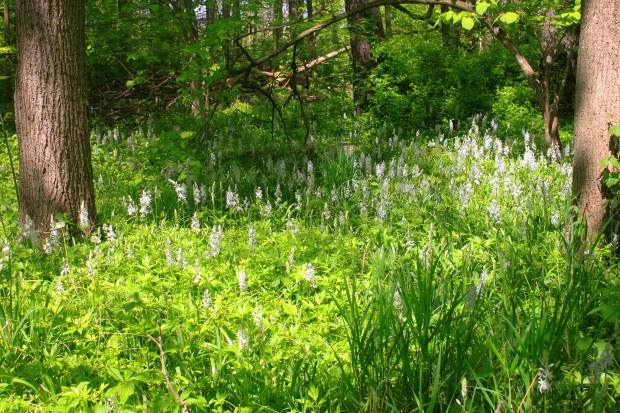Each spring season, the parade of spring ephemerals beckons visitors to the woods. There, native wildflowers unfold, each in their own time to produce glorious blooms before the tree canopy closes blocking out the sun.
Spring ephemerals can bloom early because they store food in their bulbs from last year’s growth. The amount of moisture in spring also contributes to how prolific they are, and when they are in full bloom.
It’s become my tradition to visit, for example, Reed Turner Woodlands to look for Virginia bluebells in mid to late April, and then on to Wright Woods in early May to admire the great white trillium.
The last hurrah for me is finding wild hyacinths, usually at the end of May or beginning of June. It’s often the dramatic ending to the spring wildflower season.
This year is different, however. Wild hyacinths were already blooming in the middle of May at both Wright Woods and Reed Turner Woodland. As a group, they created lilting, white patterns that seemed to connect one oak tree to another.
I have never seen so many wild hyacinths blooming so early. The mostly warm, wet spring likely favored the early and copious growth of the wild hyacinths, as well as some of the other ephemerals that bloomed earlier than normal.
One of the largest expanses of wild hyacinths in the world occurs at Wolf Road Prairie in Westchester. If you hurry right now, you can still see them before they wilt away for summer.
Before discovering wild hyacinths, I only knew about the non-native garden hyacinths, sometimes called Dutch hyacinths, that come in blue, pink and white, among other colors of cultivated varieties.
Native to Africa and the Mediterranean region, these perennials can be grown fairly easily here, and produce a lovely spring scent. In our climate, gardeners plant the hyacinth bulbs in the fall and watch them come alive with blooms in spring. They do fine if left in the ground even over the winter, and don’t need to be planted every year, like some other bulbs require.
I have a few pink garden hyacinths that appear in early spring, and I let them be since they don’t spread. They are not closely related to the wild hyacinths, and belong to the genus Hyacinthas, while the wild hyacinths are in the genus Camassia.
When I discovered wild hyacinth years ago, that’s when I really understood the joy of watching the parade of spring ephemerals emerge. By late May, bloodroot, an early bloomer, had long ago dropped its blooms and the white trillium was looking pink and tattered.
That’s when wild hyacinth, native to the eastern half of North America, including Ontario and the eastern United States, are in their prime.
The bluish-white flowers bloom beginning at the bottom of the stalk, which bears narrow, long, grasslike leaves. As time passes, the entire plant is in blossom, and a large stand of them appears as if a multitude of long, bluish-white feathers were gently swaying in the wind. Inspecting one closer reveals the bright yellow stamens emanating from the six petals.
Wild hyacinth, specifically Camassia scilloides, is endangered in Wisconsin and Pennsylvania, threatened in Michigan and North Carolina, and not all that common in Illinois.
But centuries ago, they surely must have been common, as records show that both Native Americans and early European settlers ate the bulbs raw, as well as baked, roasted, boiled and dried.
Another look-alike native plant, Zigadenus elegans, known as white camas, which is more common in the western United States, but still can be found in Illinois. This species’ bulbs look identical to those of the wild hyacinth. But white camas bulbs are poisonous. Indeed, eating one could kill a grown person, and the plant is often called death camas. The non-native garden hyacinth bulbs are inedible and contain an acid that irritates the skin.
I’d love to grow wild hyacinths in my yard, and though the plant prefers moist, fertile soil, I’ve read it might be able to handle clay soil, which is in my yard.
I’ve rarely heard of gardeners planting this species. If you have planted it successfully, I’d love to hear about it. I’m considering adding some to my spring ephemerals in my garden, which contains bloodroot, wild geraniums, May apples and Jacob’s ladder among others.
Bloodroot is long gone, and the Jacob’s ladder has dropped most of its soft, delicate blue flowers. It would be wonderful if I could find a way to add wild hyacinths to my spring ephemeral collection.
Find some time this weekend to visit Wright Woods, Reed Turner Woodland or Wolf Prairie to enjoy one of the best showings of wild hyacinth I’ve seen in a long time.
Sheryl DeVore has worked as a full-time and freelance reporter, editor and photographer for the Chicago Tribune and its subsidiaries. She’s the author of several books on nature and the environment. Send story ideas and thoughts to sheryldevorewriter@gmail.com.



